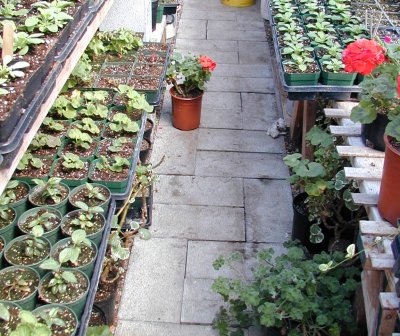This is how the entry to the greenhouse looks this time of year.

And this is what the greenhouse floor looks like.

Thanks to a bit of hard work and some pre planning we do not have to battle weeds or walk in mud.
The first year we put the greenhouse up we did not have time for a proper floor. That first year we only had time to get the new cover on and thaw things out. We had assembled the foundation and frame the past fall with the idea that we would put new plastic up the following spring.
That next spring we brought a salamander heater in to thaw things out. We did not have heat or ventilation yet but the electricity had been run out that past fall. Kristopher dug a 130 foot trench for the underground conduit that carries the 220 power, telephone and data cables.
Our property is the low spot in an area of more than 100 acres and so it tends to be wet in the spring. We must wear boots when we go back to work because some of the water is 6 inches deep.
So that first year we had a soggy mess in the greenhouse. We did not consider the water would pass under the foundation beams and into the greenhouse but it did. As a matter of fact it just about flowed through. But there was nothing we could do. We could not bring in stone because the ground would not support a truck and there was no way we were going to try and wheel barrow 10 tons of stone over the 130 foot long path.
Our first greenhouse floor was made up from pieces of landscape fabric over the turf that was on the floor. The fabric was held in place by the bench supports and until things dried up we had to wear boots in the greenhouse.
When things warmed up the grass and weeds began to grow where ever it could, pushing the cloth up in spots. This would never do.
In July, when the season began to draw down, we set our sights on the greenhouse floor. The original plan was to bury pex tubing in the floor and pump water from a water heater through it but we felt pressured to get something down and didn’t follow through with that plan. We decided that we could bury the tubing at a later date if we wanted to.
We wanted to use crushed red granite because we like the look but it is not so good to walk on. The granite is like little marbles and does not compact the way crush limestone does. Since we were going to have a set bench layout we decided to use paving blocks on top of the granite to make a level walking surface.
The first step was to remove the sod. That stuff really smelled bad because we had burred it under the fabric but it had to go. If we had left the sod it would have rotted, which would have smelled bad. In addition to the smell the rotting sod would not make a good base for the stone. So we cut it out and wheel barrow it away. The floor is 14 by 32 and this was the hardest part of the whole project.
After we cut the sod out and levelled the floor we began to bring the stone in. We had a dump truck deliver the stone, now that the ground would support the weight. It was a big pile but we made short work of filling the floor in.
But before we did the stone we put down 2 layers fabric to block mud. The last thing we wanted is mud being forced into the stone. We brought the stone up about 3 inches above the original level of the ground inside the greenhouse. The total depth of stone is about 6 inches. This way the water can flow through with out rising to a level that would make working difficult. It also makes a floor that self drains once the yard dries up, which is the time we are using a watering hose.
This floor is nice to work on and can be warm when the sun is baking on it. When we put the next house up the greenhouse floor will be crusher run lime stone. The next house will be wider and we want to be able to change the layout if we want to and the crusher run will make a nice strong and dry place to work.
Crushed limestone is graded into different sizes at the plant using screens. The stone we want to use is one of the last to pass through the screen and is called crusher run. It’s a mix of stones, the largest of which are about 1 inches down to limestone dust. The benefit of this mix it its ability to pack tight into a surface that will not move around when someone walks on it. This is not the case with the granite stone pea gravel that is uniform size and is like walking on a pile of gravel. It really never packs down.

Leave a Reply
You must be logged in to post a comment.